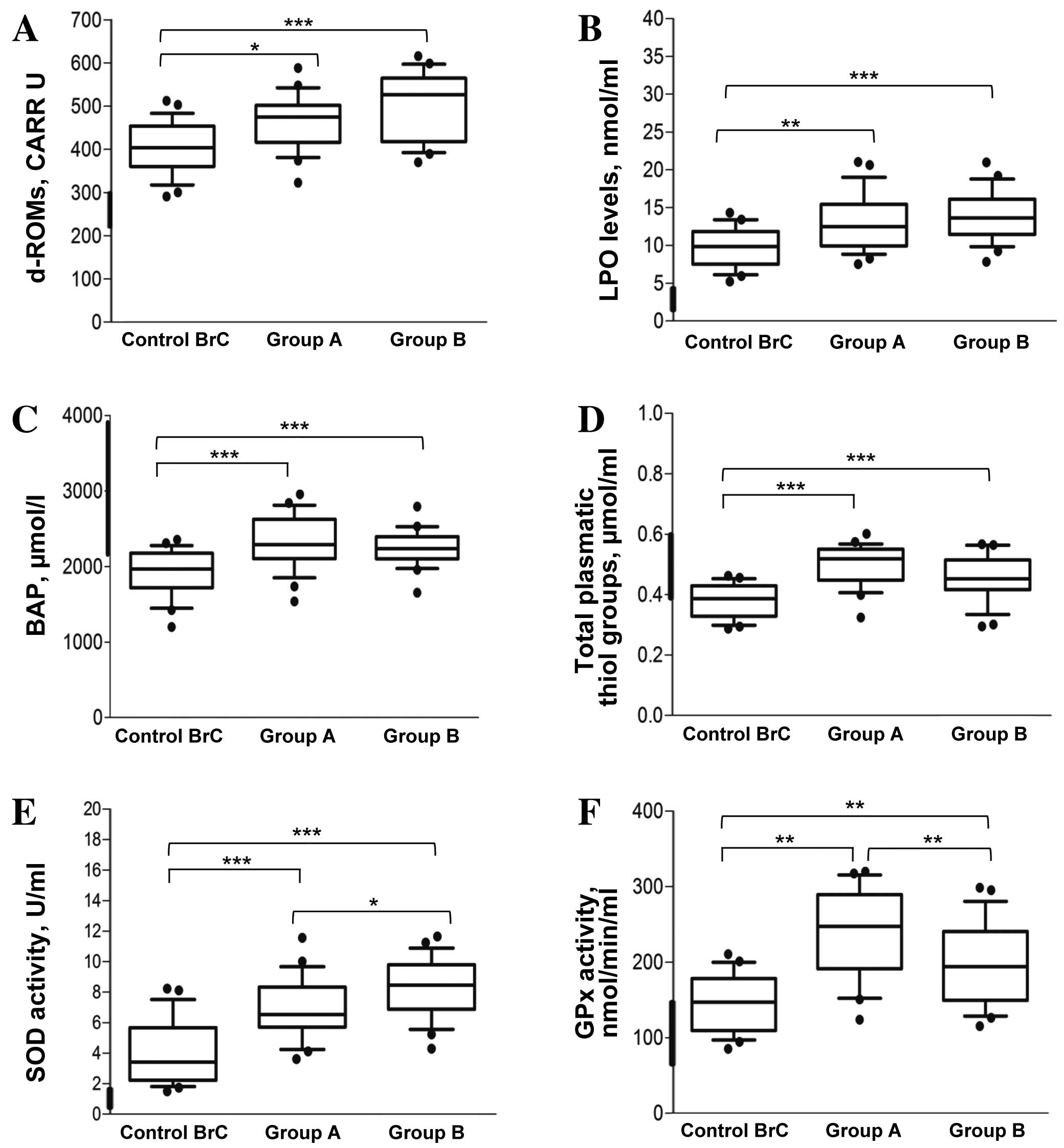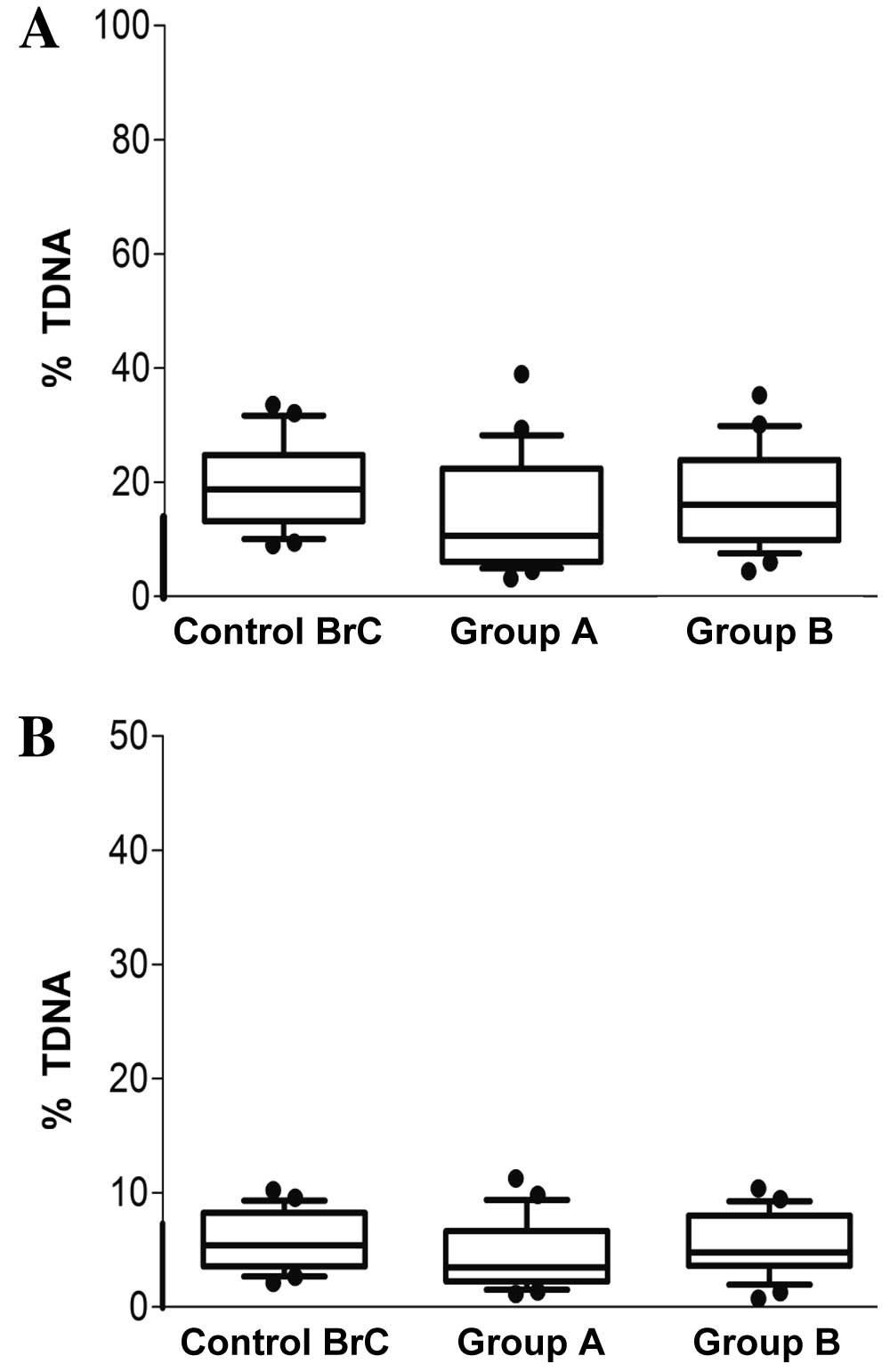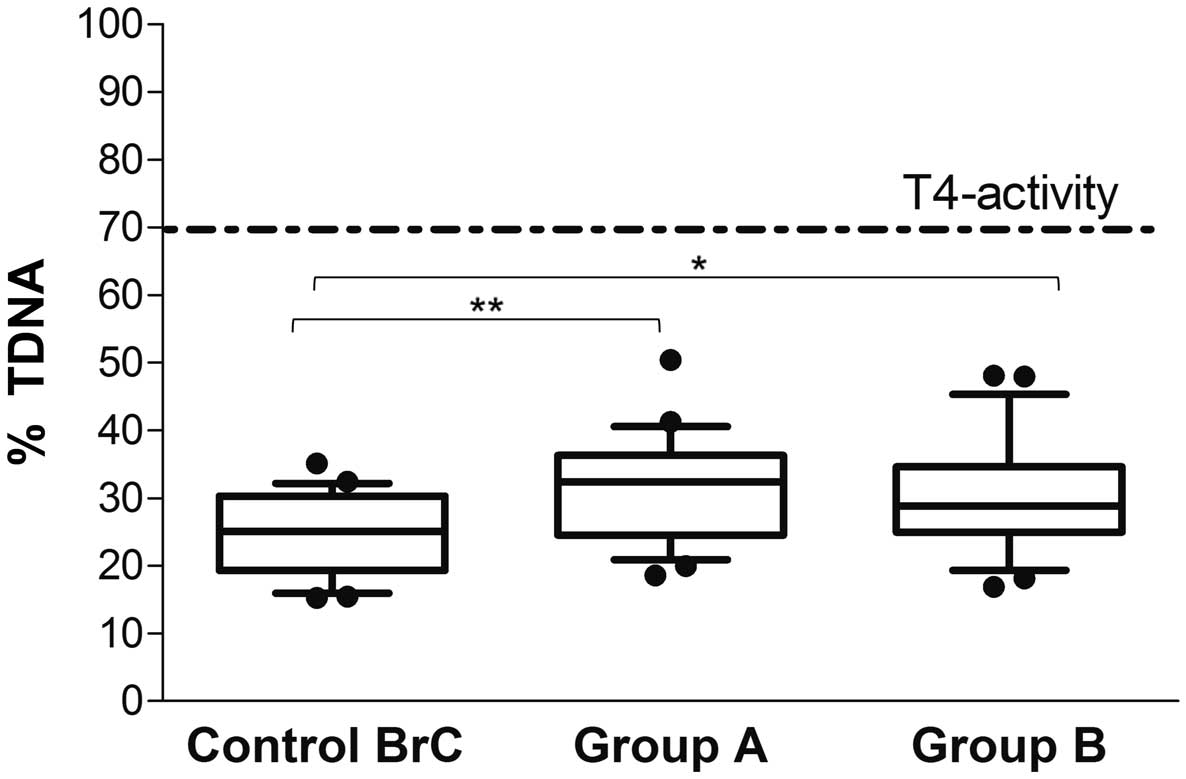|
1
|
Carlson RW, Allred DC, Anderson BO,
Burstein HJ, Carter WB, Edge SB, Erban JK, Farrar WB, Goldstein LJ,
Gradishar WJ, et al: Breast cancer. Clinical practice guidelines in
oncology. J Natl Compr Canc Netw. 7:122–192. 2009.PubMed/NCBI
|
|
2
|
Acharya A, Das I, Chandhok D and Saha T:
Redox regulation in cancer: A double-edged sword with therapeutic
potential. Oxid Med Cell Longev. 3:23–34. 2010. View Article : Google Scholar : PubMed/NCBI
|
|
3
|
Martin KR and Barrett JC: Reactive oxygen
species as double-edged swords in cellular processes: Low-dose cell
signaling versus high-dose toxicity. Hum Exp Toxicol. 21:71–75.
2002. View Article : Google Scholar : PubMed/NCBI
|
|
4
|
Cooke MS, Evans MD, Dizdaroglu M and Lunec
J: Oxidative DNA damage: Mechanisms, mutation, and disease. FASEB
J. 17:1195–1214. 2003. View Article : Google Scholar : PubMed/NCBI
|
|
5
|
Klaunig JE, Kamendulis LM and Hocevar BA:
Oxidative stress and oxidative damage in carcinogenesis. Toxicol
Pathol. 38:96–109. 2010. View Article : Google Scholar : PubMed/NCBI
|
|
6
|
Scott TL, Rangaswamy S, Wicker CA and
Izumi T: Repair of oxidative DNA damage and cancer: Recent progress
in DNA base excision repair. Antioxid Redox Signal. 20:708–726.
2014. View Article : Google Scholar : PubMed/NCBI
|
|
7
|
McCausland LL: Dragon boat racing: Life
after breast cancer treatment. Am J Nurs. 110:48–54. 2010.
View Article : Google Scholar : PubMed/NCBI
|
|
8
|
Hull MM: Lymphedema in women treated for
breast cancer. Semin Oncol Nurs. 16:226–237. 2000. View Article : Google Scholar : PubMed/NCBI
|
|
9
|
Bouillet T, Bigard X, Brami C, Chouahnia
K, Copel L, Dauchy S, Delcambre C, Descotes JM, Joly F, Lepeu G, et
al: Role of physical activity and sport in oncology: Scientific
commission of the National Federation Sport and Cancer CAMI. Crit
Rev Oncol Hematol. 94:74–86. 2015. View Article : Google Scholar : PubMed/NCBI
|
|
10
|
Knop K, Schwan R, Bongartz M, Bloch W,
Brixius K and Baumann F: Sport and oxidative stress in oncological
patients. Int J Sports Med. 32:960–964. 2011. View Article : Google Scholar : PubMed/NCBI
|
|
11
|
McCullough LE, Santella RM, Cleveland RJ,
Bradshaw PT, Millikan RC, North KE, Olshan AF, Eng SM, Ambrosone
CB, Ahn J, et al: Polymorphisms in oxidative stress genes, physical
activity, and breast cancer risk. Cancer Causes Control.
23:1949–958. 2012. View Article : Google Scholar : PubMed/NCBI
|
|
12
|
NLN Medical Advisory Committee, . Position
statement of the National Lymphedema Network: exercise. San
Francisco: National Lymphedema Network; 2013
|
|
13
|
Trotti R, Carratelli M and Barbieri M:
Performance and clinical application of a new, fast method for the
detection of hydroperoxides in serum. Panminerva Med. 44:37–40.
2002.PubMed/NCBI
|
|
14
|
Benzie IF and Strain JJ: The ferric
reducing ability of plasma (FRAP) as a measure of ‘antioxidant
power’: The FRAP assay. Anal Biochem. 239:70–76. 1996. View Article : Google Scholar : PubMed/NCBI
|
|
15
|
Di Giacomo C, Acquaviva R, Sorrenti V,
Vanella A, Grasso S, Barcellona ML, Galvano F, Vanella L and Renis
M: Oxidative and antioxidant status in plasma of runners: Effect of
oral supplementation with natural antioxidants. J Med Food.
12:145–150. 2009. View Article : Google Scholar : PubMed/NCBI
|
|
16
|
Paglia DE and Valentine WN: Studies on the
quantitative and qualitative characterization of erythrocyte
glutathione peroxidase. J Lab Clin Med. 70:158–169. 1967.PubMed/NCBI
|
|
17
|
Sandström J, Nilsson P, Karlsson K and
Marklund SL: 10-fold increase in human plasma extracellular
superoxide dismutase content caused by a mutation in
heparin-binding domain. J Biol Chem. 269:19163–19166.
1994.PubMed/NCBI
|
|
18
|
Tomasello B, Grasso S, Malfa G, Stella S,
Favetta M and Renis M: Double-face activity of resveratrol in
voluntary runners: Assessment of DNA damage by comet assay. J Med
Food. 15:441–447. 2012. View Article : Google Scholar : PubMed/NCBI
|
|
19
|
European Standards Committee on Oxidative
DNA Damage (ESCODD), . Measurement of DNA oxidation in human cells
by chromatographic and enzymic methods. Free Radic Biol Med.
34:1089–1099. 2003. View Article : Google Scholar : PubMed/NCBI
|
|
20
|
Russo A, Palumbo M, Aliano C, Lempereur L,
Scoto G and Renis M: Red wine micronutrients as protective agents
in Alzheimer-like induced insult. Life Sci. 72:2369–2379. 2003.
View Article : Google Scholar : PubMed/NCBI
|
|
21
|
Collins AR, Dusinská M, Horváthová E,
Munro E, Savio M and Stĕtina R: Inter-individual differences in
repair of DNA base oxidation, measured in vitro with the comet
assay. Mutagenesis. 16:297–301. 2001. View Article : Google Scholar : PubMed/NCBI
|
|
22
|
Gaivão I, Piasek A, Brevik A, Shaposhnikov
S and Collins AR: Comet assay-based methods for measuring DNA
repair in vitro; estimates of inter- and intra-individual
variation. Cell Biol Toxicol. 25:45–52. 2009. View Article : Google Scholar : PubMed/NCBI
|
|
23
|
Harris SR and Niesen-Vertommen SL:
Challenging the myth of exercise-induced lymphedema following
breast cancer: A series of case reports. J Surg Oncol. 74:95–99.
2000. View Article : Google Scholar : PubMed/NCBI
|
|
24
|
Fu MR, Ridner SH and Armer J: Post-breast
cancer. Lymphedema: Part 1. Am J Nurs. 109:48–54; quiz 55. 2009.
View Article : Google Scholar : PubMed/NCBI
|
|
25
|
Mandelblatt JS, Luta G, Kwan ML, Makgoeng
SB, Ergas IJ, Roh JM, Sternfeld B, Adams-Campbell LL and Kushi LH:
Associations of physical activity with quality of life and
functional ability in breast cancer patients during active adjuvant
treatment: The Pathways Study. Breast Cancer Res Treat.
129:521–529. 2011. View Article : Google Scholar : PubMed/NCBI
|
|
26
|
Vera-Ramirez L, Sanchez-Rovira P,
Ramirez-Tortosa MC, Ramirez-Tortosa CL, Granados-Principal S,
Lorente JA and Quiles JL: Free radicals in breast carcinogenesis,
breast cancer progression and cancer stem cells. Biological bases
to develop oxidative-based therapies. Crit Rev Oncol Hematol.
80:347–368. 2011. View Article : Google Scholar : PubMed/NCBI
|
|
27
|
Aslan R, Kutlu R, Civi S and Tasyurek E:
The correlation of the total antioxidant status (TAS), total
oxidant status (TOS) and paraoxonase activity (PON1) with smoking.
Clin Biochem. 47:393–397. 2014. View Article : Google Scholar : PubMed/NCBI
|
|
28
|
Shen J, Gammon MD, Terry MB, Wang Q,
Bradshaw P, Teitelbaum SL, Neugut AI and Santella RM: Telomere
length, oxidative damage, antioxidants and breast cancer risk. Int
J Cancer. 124:1637–1643. 2009. View Article : Google Scholar : PubMed/NCBI
|
|
29
|
Fortner RT, Tworoger SS, Wu T and Eliassen
AH: Plasma florescent oxidation products and breast cancer risk:
Repeated measures in the Nurses' Health Study. Breast Cancer Res
Treat. 141:307–316. 2013. View Article : Google Scholar : PubMed/NCBI
|
|
30
|
Rajneesh CP, Manimaran A, Sasikala KR and
Adaikappan P: Lipid peroxidation and antioxidant status in patients
with breast cancer. Singapore Med J. 49:640–643. 2008.PubMed/NCBI
|
|
31
|
Abiaka C, Al-Awadi F, Al-Sayer H, Gulshan
S, Behbehani A and Farghally M: Activities of erythrocyte
antioxidant enzymes in cancer patients. J Clin Lab Anal.
16:167–171. 2002. View Article : Google Scholar : PubMed/NCBI
|
|
32
|
Kasapović J, Pejić S, Todorović A,
Stojiljković V and Pajović SB: Antioxidant status and lipid
peroxidation in the blood of breast cancer patients of different
ages. Cell Biochem Funct. 26:723–730. 2008. View Article : Google Scholar : PubMed/NCBI
|
|
33
|
Hasan HR, Mathkor TH and Al-Habal MH:
Superoxide dismutase isoenzyme activities in plasma and tissues of
Iraqi patients with breast cancer. Asian Pac J Cancer Prev.
13:2571–2576. 2012. View Article : Google Scholar : PubMed/NCBI
|
|
34
|
Gago-Dominguez M, Jiang X and Castelao J
Esteban: Lipid peroxidation and the protective effect of physical
exercise on breast cancer. Med Hypotheses. 68:1138–1143. 2007.
View Article : Google Scholar : PubMed/NCBI
|
|
35
|
Balneaves LG, Van Patten C, Truant TL,
Kelly MT, Neil SE and Campbell KL: Breast cancer survivors'
perspectives on a weight loss and physical activity lifestyle
intervention. Support Care Cancer. 22:2057–65. 2014.PubMed/NCBI
|
|
36
|
Carter CL, Onicescu G, Cartmell KB, Sterba
KR, Tomsic J, Fox T, Dunmeyer E and Alberg AJ: Factors associated
with cancer survivors' selection between two group physical
activity programs. J Cancer Surviv. 4:388–398. 2010. View Article : Google Scholar : PubMed/NCBI
|
|
37
|
Kobayashi M and Yamamoto M: Molecular
mechanisms activating the Nrf2-Keap1 pathway of antioxidant gene
regulation. Antioxid Redox Signal. 7:385–394. 2005. View Article : Google Scholar : PubMed/NCBI
|
|
38
|
Carayol M, Romieu G, Bleuse JP, Senesse P,
Gourgou-Bourgade S, Sari C, Jacot W, Sancho-Garnier H, Janiszewski
C, Launay S, et al: Adapted physical activity and diet (APAD)
during adjuvant breast cancer therapy: Design and implementation of
a prospective randomized controlled trial. Contemp Clin Trials.
36:531–543. 2013. View Article : Google Scholar : PubMed/NCBI
|
|
39
|
Sánchez P, Peñarroja R, Gallegos F, Bravo
JL, Rojas E and Benítez-Bribiesca L: DNA damage in peripheral
lymphocytes of untreated breast cancer patients. Arch Med Res.
35:480–483. 2004. View Article : Google Scholar : PubMed/NCBI
|
|
40
|
Hussien MM, McNulty H, Armstrong N,
Johnston PG, Spence RA and Barnett Y: Investigation of systemic
folate status, impact of alcohol intake and levels of DNA damage in
mononuclear cells of breast cancer patients. Br J Cancer.
92:1524–1530. 2005. View Article : Google Scholar : PubMed/NCBI
|
|
41
|
Shahidi M, Mozdarani H and Bryant PE:
Radiation sensitivity of leukocytes from healthy individuals and
breast cancer patients as measured by the alkaline and neutral
comet assay. Cancer Lett. 257:263–273. 2007. View Article : Google Scholar : PubMed/NCBI
|
|
42
|
Mao Z, Hine C, Tian X, Van Meter M, Au M,
Vaidya A, Seluanov A and Gorbunova V: SIRT6 promotes DNA repair
under stress by activating PARP1. Science. 332:1443–1446. 2011.
View Article : Google Scholar : PubMed/NCBI
|

















